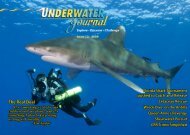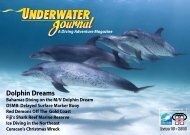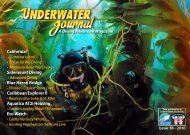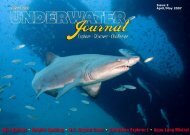- REBREATHERS - SPORT DIVERS ... - Stingray Divers
- REBREATHERS - SPORT DIVERS ... - Stingray Divers
- REBREATHERS - SPORT DIVERS ... - Stingray Divers
Create successful ePaper yourself
Turn your PDF publications into a flip-book with our unique Google optimized e-Paper software.
years when Florida State University (FSU) and NMFS’<br />
population study is complete. But now that may not<br />
be the case.<br />
In a meeting slated for August 2007, the FWC, Fish<br />
and Wildlife Research Institute (FWC-FWRI) and the<br />
National Marine Fisheries Service, Southeast Fishery<br />
Science Center (NMFS-SEFSC) are proposing a<br />
joint, collaborative research program directed at<br />
goliath grouper in the tropical Atlantic and eastern<br />
Gulf of Mexico.<br />
At the center of this discussion is a research<br />
proposal that would include the harvest of a limited<br />
number of goliath grouper for scientific purposes.<br />
Over a two-year period, the program would kill an<br />
estimated 800 fish in Florida’s southern Atlantic and<br />
the eastern Gulf of Mexico.<br />
The proposal states that “biological samples<br />
(otoliths, gonad tissue, etc.) collected through this<br />
limited harvest program would be used to augment<br />
our information base on goliath grouper age, growth,<br />
and reproduction, as well as supplement ongoing<br />
studies on feeding habits. However, besides providing<br />
specimens for life history studies, we believe that<br />
development of a State-Federal Cooperative Goliath<br />
Grouper Research Program will improve coordination<br />
of goliath grouper research activities being currently<br />
conducted or planned by scientists at FWC-FWRI,<br />
NMFS, and Florida State University, as well as<br />
facilitate consistent management of this species in<br />
state and federal waters.”<br />
For the most part, all of the tests suggested in this<br />
program could be accomplished without killing the fish<br />
– as has been the case for the past 16 years. So why<br />
kill these fish for no good reason? Many informed<br />
members of the fishing and scientific communities see<br />
this program as nothing more than an appeasement<br />
to specific fishing groups. Especially when the first<br />
listed recommended in this program proposes (in<br />
response to recent public interest in reopening the<br />
fishery) scientific research projects developed under<br />
the Cooperative Goliath Grouper Research Program<br />
(CGGRP) be conducted with the assistance of<br />
commercial and/or recreational fishers (e.g. for the<br />
collection of specimens). Fishers participating in this<br />
program would be required to coordinate activities with<br />
scientists submitting proposals to the CGGRP so their<br />
names can be listed in scientific collection permits<br />
issued by the Florida Fish and Wildlife Conservation<br />
Commission (for state waters) and/or the National<br />
Marine Fisheries Service (for federal waters).<br />
Florida’s Fish and Wildlife Conservation<br />
Commission would issue 800 numbered plastic<br />
“harvest tags” (similar to kill tags issued by the FWC<br />
for tarpon) to be distributed to scientists participating<br />
in the CGGRP. What remains vague is how the<br />
collected goliath grouper specimens will be delivered<br />
to scientists facilitating this research program.<br />
On closer examination, one might conclude that<br />
this collection plan is nothing more than a loophole<br />
to allow commercial fishermen to kill the ever-soimportant<br />
large goliaths under the guise of science. If<br />
management of a species, especially one considered<br />
critically endangered throughout its range outside of<br />
US waters by the World Conservation Union (IUCN),<br />
is allowed to be governed by special interest groups<br />
more interested in appeasing their constituency, the<br />
fate of the goliath could be grim. How important is<br />
it for you to see a few big fish next time you’re out<br />
diving on the reef?<br />
Walt Stearns<br />
Editor-in-Chief<br />
Call to Action….<br />
Opposed?<br />
If you’re not in favor of the plan<br />
proposed by the Cooperative<br />
Goliath Grouper Research<br />
Program (CGGRP)...<br />
Write, email or call:<br />
Luiz Barbieri, Researcher<br />
Department for Marine Fisheries<br />
Research<br />
Florida Fish and Wildlife Conservation<br />
Commission (FWC)<br />
Fish and Wildlife Research Institute<br />
100 8th Avenue SE<br />
St. Petersburg, FL 33701-5020<br />
Email: Luiz.Barbieri@fwc.state.fl.us.<br />
Alex Chester, Science and<br />
Research Director<br />
Southeast Fisheries Science Center<br />
75 Virginia Beach Drive<br />
Miami, Florida 33149<br />
E mail: alex.chester@noaa.gov<br />
PH: 305-361-4259, ex: 259<br />
www.underwaterjournal.com June/July 2007






